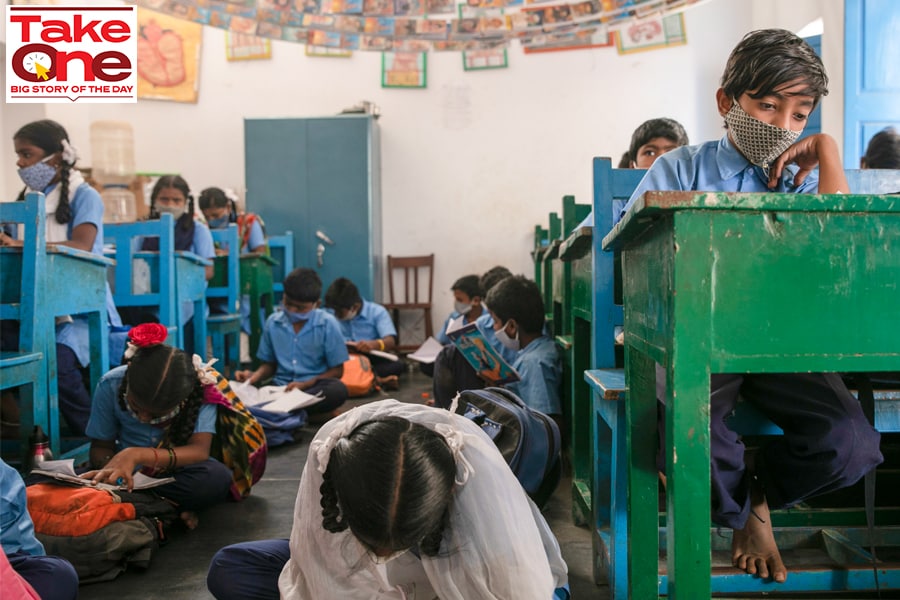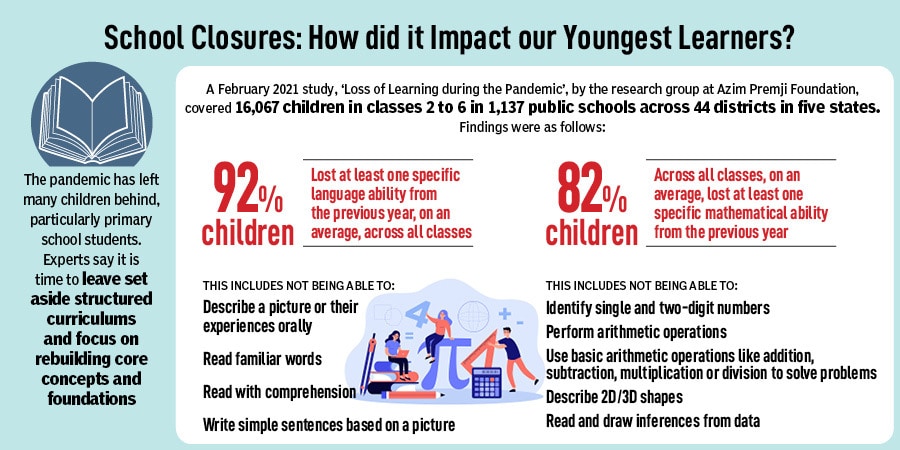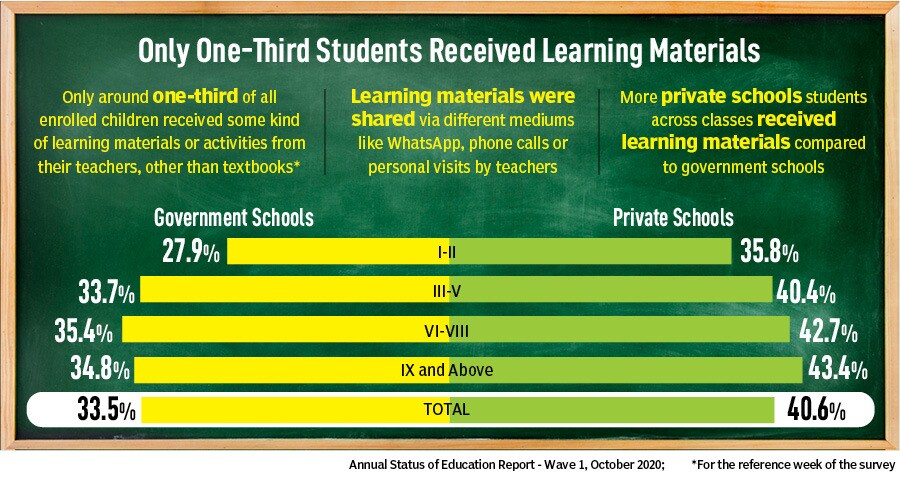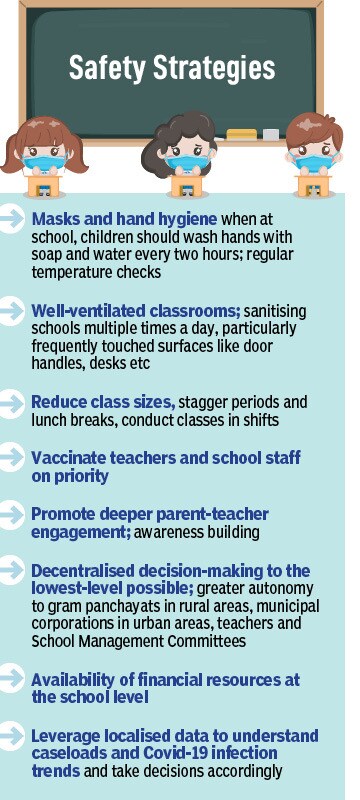Now, over the past 1.5 years, ever since the first Covid-19 lockdown in March 2020, Chandra and fellow teachers have been going door-to-door to speak with parents and ensure their children do not drop out of school. They have also been home-delivering worksheets.
Even in the rare cases that children have had access to a smartphone, classes have had to be held in the evenings, when parents return home after work and hand over their phone to the kids for teachers to contact them. Besides, many a times, now parents send their kids off to the fields for livestock grazing at the time they would have been in school, so kids routinely lose those three-four hours of study time too, Chandra says. “Bahut nuksaan hua hai," he rues. Children have really lost out a lot.
![]() Jharkhand reopened schools for Classes 9 to 12 on August 2. The other classes are waiting for government guidelines, Chandra says, “Yahaan toh sab chahate hain ki school khul jaaye." Everyone here wants schools to reopen. For parents, it means putting their kids on a path away from illiteracy and poverty. For teachers, it is a way to make sure children actually learn and benefit from education.
Jharkhand reopened schools for Classes 9 to 12 on August 2. The other classes are waiting for government guidelines, Chandra says, “Yahaan toh sab chahate hain ki school khul jaaye." Everyone here wants schools to reopen. For parents, it means putting their kids on a path away from illiteracy and poverty. For teachers, it is a way to make sure children actually learn and benefit from education.
On July 27, the Central government said that states will have to take the final decision about reopening schools, in the wake of which a handful of states have made announcements [see box ‘Status Update’] and released Standard Operating Procedures (SOPs) for reopening of schools.
The Centre maintains that reopening of schools is a difficult decision, as the risk of students, teachers and staff getting infected with Covid-19 looms large. At a press conference by the health ministry on July 27, VK Paul, member-health, Niti Aayog, said that while society is concerned about learning loss, reopening schools is a “tightrope walking" scenario, because the risk of exposure to teachers, staff and children has to be weighed against how to carry out learning activities.
Why Is School Reopening An Urgent Priority?
A Parliament response by Union education minister Dharmendra Pradhan on August 2 indicated that over three crore school-going children in India do not have access to digital devices. With over 1.4 crore students, Bihar ranked highest on the list, while Rajasthan reported zero children without digital access. This data is a result of a survey the Centre advised states and Union Territories to conduct in February.
![]() The three crore number, however, is not completely representative of the situation on the ground, as data is not available from Maharashtra, Uttar Pradesh, Andaman and Nicobar Islands, Arunachal Pradesh, Goa and Manipur, while West Bengal reported ‘Survey is in Progress’. A few other states have provided percentages, with Jammu and Kashmir and Madhya Pradesh each reporting that 70 percent of children in their states do not have access to digital devices for education. Delhi, too, has reported that 4 percent of its students are unable to avail digital education.
The three crore number, however, is not completely representative of the situation on the ground, as data is not available from Maharashtra, Uttar Pradesh, Andaman and Nicobar Islands, Arunachal Pradesh, Goa and Manipur, while West Bengal reported ‘Survey is in Progress’. A few other states have provided percentages, with Jammu and Kashmir and Madhya Pradesh each reporting that 70 percent of children in their states do not have access to digital devices for education. Delhi, too, has reported that 4 percent of its students are unable to avail digital education.
According to the government’s Unified District Information System for Education (UDISE), as per academic year 2019-20, there are 26.4 crore students and 96.8 lakh teachers across 10.3 lakh government schools and 4.8 lakh private schools, from Classes 1 to 12.
Among those children who can access digital devices, there are problems of another kind. “A teacher in the Tumakuru district of Karnataka told me that out of a WhatsApp group created for 60 students, only six to seven students regularly participated in classes or discussions," says Pramod Sridharamurthy, secretary, India Literacy Project (ILP). The education non-profit equips teachers with digital content and visual aids to engage with children more effectively. They have reached over 8.73 lakh underprivileged students across 5,659 villages in seven states.
He says that while states have taken an initiative to conduct classes for children on Doordarshan, parents are unable to figure out just how much students are able to grasp and actually learn sitting in front of the television.
“And in urban settings, there are various technical glitches. Students cannot hear, they drop off and have to log in again etc.," Sridharamurthy says. “In many cases, teachers and students do not switch on video as it consumes more bandwidth. So in effect, a lesson just becomes like a podcast. Without visual contact and interaction, there is no way to actually understand whether children are paying attention and whether they have understood." According to him, teachers are doing their best and are really trying to help students, but despite everyone’s efforts, online education just becomes a check box of an activity done, with limited educational benefits.
“Online education is sub-optimal," agrees Rishikesh BS, faculty with the School of Education at the Azim Premji University. “Real learning is not happening, education is definitely not happening because education is far beyond just learning different subjects from the school syllabus." According to him, there is a huge gap between what children are learning at specific ages and what they should learn. "It is not that children have not learnt anything in the past 1.5 years, but they have also quickly forgotten. We have seen that children have lost more than two years of core concepts," he says.
![]()
According to him, the impact of school closures has been harsher for children from poor and vulnerable backgrounds. Even on regular days, many children often fell behind grade-appropriate education levels, and the learning gap has now been exacerbated. “Not to mention that for many underserved children, schools also provide a safety net from issues like early marriage, malnutrition, child labour etc."
The fourth nationwide serological survey conducted by the Indian Council of Medical Research (ICMR) in June-July included children between ages 6 and 17 years for the first time. It indicated that seroprevalence among children in the 6-9 age group and 10-17 age group was at 57.2 percent and 61.6 percent respectively. This meant that more than half the children in this age group have already been exposed to the coronavirus and have developed antibodies against it.
In Karnataka, an interim report submitted in June by a high-level committee constituted by the state government to analyse, control and advise on the Covid-19 third wave, headed by cardiologist Dr Devi Shetty, recommended reopening of schools on priority basis and in a staggered manner. “There is an urgent need to offer scientific and definitive guidance for school reopening, as any delay in achieving near normalisation of schooling will be more detrimental than Covid-19 itself," the report stated.
![]()
“The hesitation around schools reopening comes mainly from the fact that parents feel their children will be exposed to other people who are infected. But the risk of infection is more from the community, the family and the neighbourhood," says GVS Murthy, director, Indian Institute of Public Health (IIPH), Hyderabad.
Murthy is a member of a task force headed by the World Health Organization (WHO), the United Nations Children"s Fund (Unicef) and the United Nations Educational, Scientific and Cultural Organization (Unesco), which has been studying the impact of the pandemic at the school level and assessing if there is additional risk for children if they go to school.
“We are looking at evidence from a large number of countries," Murthy says, citing a December 2020 review of data from 191 countries that showed no association between school status and Covid-19 infection rates in the community, and another assessment of schools across 32 countries in Europe that showed that “reopening schools has not been associated with significant increases in community transmission".
We have to educate parents that the risk of Covid-19 transmission is higher from the community itself, and not the school, Murthy says. “The child might actually be better off going to school," he adds, not just from a physical health or education perspective, but also to leverage the benefits of social interactions and friendships at school that help develop the child’s personality.
Nooraine Fazal agrees. The co-founder of Inventure Academy, a private international school in Bengaluru, says that in the wake of the pandemic, she has seen a 25 percent increase in the number of students approaching the four counsellors in the school. “The impact on the mental health of children is huge in terms of fear, grief, social isolation and fatigue that everyone is experiencing with being online all the time. Parents are stressed as well. We really need to get kids back to school as fast as possible," she says.
Fazal—who has launched an online platform Let’s Connect Today that collaborates with other schools to provide a helpline for children—finds that the subject of schools reopening is a mixed bag with parents in urban areas. While some are reluctant to send their kids to school, others, particularly those parents who are vaccinated and have closely seen the impact of school closures on their kids, are more open to the idea of reopening schools. “The government should be working on establishing an ecosystem where there is far more trust among various stakeholders," she says.
What is the Way Forward?
Based on the experiences of the past year, there are three clear scenarios we must be prepared for, says Rukmini Banerji, CEO, Pratham Education Foundation. First, a complete lockdown where no movement is possible second, partial restrictions on movement, where teachers may be in school but not children, and third, when there are no restrictions on movement, and both teachers and parents can be in school. While schools did not know how to cope with the unfolding situation when they suddenly shut down in March 2020, now, 1.5 years down the line, each state must have a plan worked out for each of the three scenarios, she explains.
![]()
“If we are well-prepared with flexible options, schools can move into the appropriate plan as local conditions change. Given the need to be flexible, some funds need to be available to local schools and school management committees [SMCs] to use in the manner most suitable for local conditions," Banerji tells Forbes India.
Rishikesh of Azim Premji University also stresses on the need for decentralisation to the lowest, most local level possible. “A standard, one-size-fits-all approach will not work for the millions of students across our country," he says.
![]() An average state in India has about 50,000 schools, he explains, so one common decision to either open or shut them cannot be taken, and the strategy has to be one that gives more autonomy to the district or city / village-level officials [like gram panchayats in rural areas and municipal corporations in urban areas], parents, teachers and SMCs.
An average state in India has about 50,000 schools, he explains, so one common decision to either open or shut them cannot be taken, and the strategy has to be one that gives more autonomy to the district or city / village-level officials [like gram panchayats in rural areas and municipal corporations in urban areas], parents, teachers and SMCs.
Practising physical distancing might not always be possible, so students have to be taught in small groups and batches, with periods and lunch breaks staggered. Teachers need to be given more flexibility with the curriculum. Decentralising decision-making can help the government increase accountability and ownership among other stakeholders, including parents, teachers and schools, he says.
“Nobody is thinking hard about it," says Rishikesh, referring to states. For instance, he explains, opening of primary schools needs to be given more priority over secondary schools and colleges. “But there continues to be this obsession with Board exams," he says.
The academician points to how the National Education Policy (NEP), with a firm focus on foundational education, says that the first eight years of a child’s life are crucial. “Children are already two years behind from their grade-appropriate levels of learning. While high school students have some foundational base and can also study on their own if provided with materials, that is not the case with younger, primary school children. So those children should be our first focus."
The risk of contracting infections is lowest at younger ages, reiterates Murthy of IIPH, so primary school children should be the first ones to be back in school compared to high school students, whose return can be staggered over a couple of weeks. Inoculation of all adult stakeholders, according to him, should also be top priority. “There is a problem with the stock and supply of the Covid-19 vaccine, so we might not have adequate doses, but at least one dose needs to be administered to teachers and school staff on priority, considering them equivalent to frontline workers," he says.
Fazal of Inventure Academy says schools that can afford it should make investments in rigorous point-to-point safety checks, including air filters in school buses, temperature and oxygen checks of everyone entering the campus, vaccinating teachers, staff and school administration, well-ventilated classrooms, doors with automated systems that kids can push open with their feet instead of hands, and washrooms with sensor-based taps.
“It [decision on safety protocols] must be left to schools, according to what is happening in their areas or communities," she says. According to her, the government must stay on top of data parameters to identify local and community transmission trends, take a call on what should be a containment zone, and which child should or should not be going to school depending on the caseloads in their respective apartment buildings or neighbourhoods. “Create operational guidelines and best practices on tracing, testing etc. in close collaboration with the school administration, teachers, staff and parents," she says.
Rishikesh of Azim Premji University points out that even after schools reopen, it will not be business as usual, since it will take time to undo what children have lost over the past 1.5 years. “It is not going to be normal for another year, or even two," he says. In Karnataka, for instance, members of the committee for school reopening have suggested to the state government that they should try to keep schools open for at least 300 of the next 500 days after schools reopen. “During this period, we can get all children to first catch up with basics and then start with grade-level concepts," he says.
Teachers will have to deal with children in the same class having vastly different learning levels, so the curriculum will have to be rejigged in a way that will give teachers the time and flexibility to start at least two grades below every class to help kids catch up. “We have to look at learning outcomes, identify core concepts for those outcomes and put in efforts accordingly," says Rishikesh. “The usual annual syllabus-oriented approach will not do."
Murthy says that reopening of schools is non-negotiable with a view of the long-term needs of the future generation, but at the same time, we must constantly track the level of infection in the community and prepare the school environment accordingly. “That is when it will be safe for everybody."

 Reopening of schools is non-negotiable with a view of the long-term needs of the future generation, experts say, but at the same time, it"s important to track the level of Covid-19 infection in the community and prepare the school environment accordingly Image: Selvaprakash Lakshmanan[br]
Reopening of schools is non-negotiable with a view of the long-term needs of the future generation, experts say, but at the same time, it"s important to track the level of Covid-19 infection in the community and prepare the school environment accordingly Image: Selvaprakash Lakshmanan[br]
 Jharkhand reopened schools for Classes 9 to 12 on August 2. The other classes are waiting for government guidelines, Chandra says, “Yahaan toh sab chahate hain ki school khul jaaye." Everyone here wants schools to reopen. For parents, it means putting their kids on a path away from illiteracy and poverty. For teachers, it is a way to make sure children actually learn and benefit from education.
Jharkhand reopened schools for Classes 9 to 12 on August 2. The other classes are waiting for government guidelines, Chandra says, “Yahaan toh sab chahate hain ki school khul jaaye." Everyone here wants schools to reopen. For parents, it means putting their kids on a path away from illiteracy and poverty. For teachers, it is a way to make sure children actually learn and benefit from education.



 An average state in India has about 50,000 schools, he explains, so one common decision to either open or shut them cannot be taken, and the strategy has to be one that gives more autonomy to the district or city / village-level officials [like gram panchayats in rural areas and municipal corporations in urban areas], parents, teachers and SMCs.
An average state in India has about 50,000 schools, he explains, so one common decision to either open or shut them cannot be taken, and the strategy has to be one that gives more autonomy to the district or city / village-level officials [like gram panchayats in rural areas and municipal corporations in urban areas], parents, teachers and SMCs.